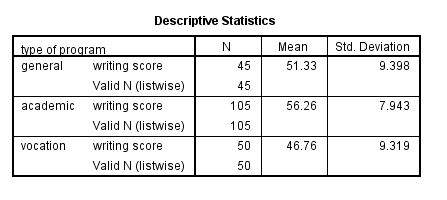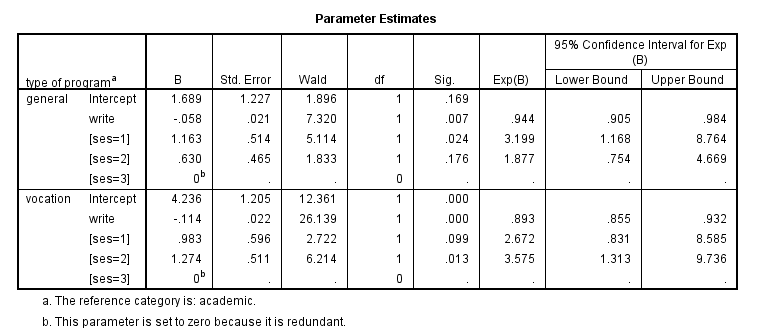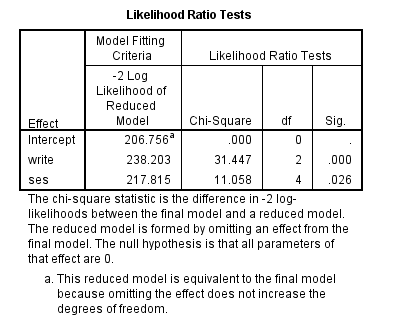Version info: Code for this page was tested in SPSS 20.
Multinomial logistic regression is used to model nominal outcome variables, in which the log odds of the outcomes are modeled as a linear combination of the predictor variables.
Please note: The purpose of this page is to show how to use various data analysis commands. It does not cover all aspects of the research process which researchers are expected to do. In particular, it does not cover data cleaning and checking, verification of assumptions, model diagnostics and potential follow-up analyses.
Examples of multinomial logistic regression
Example 1. People’s occupational choices might be influenced by their parents’ occupations and their own education level. We can study the relationship of one’s occupation choice with education level and father’s occupation. The occupational choices will be the outcome variable which consists of categories of occupations.
Example 2. A biologist may be interested in food choices that alligators make. Adult alligators might have difference preference than young ones. The outcome variable here will be the types of food, and the predictor variables might be the length of the alligators and other environmental variables.
Example 3. Entering high school students make program choices among general program, vocational program and academic program. Their choice might be modeled using their writing score and their social economic status.
Description of the data
For our data analysis example, we will expand the third example using the hsbdemo data set. You can download the data here.
The data set contains variables on 200 students. The outcome variable is prog, program type. The predictor variables are social economic status, ses, a three-level categorical variable and writing score, write, a continuous variable. Let’s start with getting some descriptive statistics of the variables of interest.
get data "D:\data\hsbdemo.sav".crosstabs /tables=prog by ses /statistics=chisq /cells=count.sort cases by prog. split file by prog. descriptives var = write /statistics = mean stddev. split file off.

Analysis methods you might consider
- Multinomial logistic regression: the focus of this page.
- Multinomial probit regression: similar to multinomial logistic regression but with independent normal error terms.
- Multiple-group discriminant function analysis: A multivariate method for multinomial outcome variables
- Multiple logistic regression analyses, one for each pair of outcomes: One problem with this approach is that each analysis is potentially run on a different sample. The other problem is that without constraining the logistic models, we can end up with the probability of choosing all possible outcome categories greater than 1.
- Collapsing number of categories to two and then doing a logistic regression: This approach suffers from loss of information and changes the original research questions to very different ones.
- Ordinal logistic regression: If the outcome variable is truly ordered and if it also satisfies the assumption of proportional odds, then switching to ordinal logistic regression will make the model more parsimonious.
- Alternative-specific multinomial probit regression: allows different error structures therefore allows to relax the independence of irrelevant alternatives (IIA, see below “Things to Consider”) assumption. This requires that the data structure be choice-specific.
- Nested logit model: also relaxes the IIA assumption, also requires the data structure be choice-specific
Using the multinomial logit model
Below we use the nomreg command to estimate a multinomial logistic regression model. We specify the baseline comparison group to be the academic group using (base=2).
nomreg prog (base = 2) by ses with write /print = lrt cps mfi parameter summary.

- The likelihood ratio chi-square of 48.23 with a p-value < 0.0001 tells us that our model as a whole fits significantly better than an empty model (i.e., a model with no predictors)
- The output above has two parts, labeled with the categories of the outcome variable prog. They correspond to the two equations below:
$$ln\left(\frac{P(prog=general)}{P(prog=academic)}\right) = b_{10} + b_{11}(ses=1) + b_{12}(ses=2) + b_{13}write$$ $$ln\left(\frac{P(prog=vocation)}{P(prog=academic)}\right) = b_{20} + b_{21}(ses=1) + b_{22}(ses=2) + b_{23}write$$ where \(b\)’s are the regression coefficients.
- A one-unit increase in the variable write is associated with a .058 decrease in the relative log odds of being in general program versus academic program .
- A one-unit increase in the variable write is associated with a .1136 decrease in the relative log odds of being in vocation program versus academic program.
- The relative log odds of being in general program versus in academic program will increase by 1.163 if moving from the highest level of ses (ses = 3) to the lowest level of ses (ses = 1).
The ratio of the probability of choosing one outcome category over the probability of choosing the baseline category is often referred to as relative risk (and it is also sometimes referred to as odds as we have just used to described the regression parameters above). Thus, exponentiating the linear equations above yields relative risks. Regression coefficients represent the change in log relative risk (log odds) per unit change in the predictor. Exponentiating regression coefficients will therefore yield relative risk ratios. SPSS includes relative risk ratios in the output, under the column “Exp(B)”.
- The relative risk ratio for a one-unit increase in the variable write is .9437 (exp(-.0579284) from the output of the nomreg command above) for being in general program versus academic program.
- The relative risk ratio switching from ses = 3 to 1 is 3.199 for being in general program versus academic program. In other words, the expected risk of staying in the general program is higher for subjects who are low in ses.
Tests for the overall effect of ses and write are outputted by the nomreg command. Below we see that the effects are statistically significant.
You can also use predicted probabilities to help you understand the model. You can calculate predicted probabilities using the SPSS matrix command. Below we calculate the predicted probability of choosing each program type at each level of ses, holding write at its means.
Matrix.
* intercept1 intercept2 pared public gpa.
* these coefficients are taken from the output.
compute b_gen = {1.689354 ; -0.057928 ; 1.162832 ; 0.629541}.
compute b_voc = {4.235530 ; -0.113603 ; 0.982670 ; 1.274063}.
* overall design matrix including means of public and gpa.
compute x = {{1 ; 1; 1}, make(3, 1, 52.775), {1, 0; 0, 1; 0, 0}}.
compute lp_gen = exp(x * b_gen).
compute lp_voc = exp(x * b_voc).
compute lp_aca = {1; 1; 1}.
compute p_gen = lp_gen/(lp_aca + lp_gen + lp_voc).
compute p_voc = lp_voc/(lp_aca + lp_gen + lp_voc).
compute p_aca = lp_aca/(lp_aca + lp_gen + lp_voc).
compute p = {p_gen, p_aca, p_voc}.
print p /title 'Predicted Probabilities for Outcomes 1 2 3 for ses 1 2 3 at mean of write'.
End Matrix.
Run MATRIX procedure:
Predicted Probabilities for Outcomes 1 2 3 for ses 1 2 3 at mean of write
.3581989665 .4396824687 .2021185647
.2283388262 .4777491509 .2939120229
.1784967500 .7009009604 .1206022896
------ END MATRIX -----
Column 1 contains the predicted probabilities for prog = general, where ses equals 1, 2 and 3 on each successive row. Columns 2 and 3 are the same for prog = academic and prog = vocational, respectively. We can also calculate predicted probabilities as we vary write from 30 to 70, when ses = 1.
Matrix.
* intercept1 intercept2 pared public gpa.
* these coefficients are taken from the output.
compute b_gen = {1.689354 ; -0.057928 ; 1.162832 ; 0.629541}.
compute b_voc = {4.235530 ; -0.113603 ; 0.982670 ; 1.274063}.
* overall design matrix including means of public and gpa.
compute x = {make(5,1,1), {30; 40; 50; 60; 70}, make(5,1,1), make(5,1,0)}.
compute lp_gen = exp(x * b_gen).
compute lp_voc = exp(x * b_voc).
compute lp_aca = {1; 1; 1; 1; 1}.
compute p_gen = lp_gen/(lp_aca + lp_gen + lp_voc).
compute p_voc = lp_voc/(lp_aca + lp_gen + lp_voc).
compute p_aca = lp_aca/(lp_aca + lp_gen + lp_voc).
compute p = {p_gen, p_aca, p_voc}.
print p /title 'Predicted Probabilities for Outcomes 1 2 3 for write 30 40 50 60 70 at ses=1'.
End Matrix.
Run MATRIX procedure:
Predicted Probabilities for Outcomes 1 2 3 for write 30 40 50 60 70 at ses=1
.2999966732 .0984378501 .6015654767
.3656613530 .2141424912 .4201961559
.3698577661 .3865775582 .2435646757
.3083735022 .5752505689 .1163759289
.2199925775 .7324300249 .0475773976
------ END MATRIX -----
Column 1 contains the predicted probabilities for prog = general, where write equals 30, 40, 50, 60 and 70 for rows 1 through 5, respectively. Columns 2 and 3 are the same for prog = academic and prog = vocational, respectively.
Things to consider
- The independence of irrelevant alternatives (IIA) assumption: roughly, the IIA assumption means that adding or deleting alternative outcome categories does not affect the odds among the remaining outcomes. There are alternative modeling methods that relax the IIA assumption, such as alternative-specific multinomial probit models or nested logit models.
- Diagnostics and model fit: unlike logistic regression where there are many statistics for performing model diagnostics, it is not as straightforward to do diagnostics with multinomial logistic regression models. For the purpose of detecting outliers or influential data points, one can run separate logistic regression models and use the diagnostics tools on each model.
- Pseudo-R-Squared: the R-squared offered in the output is basically the change in terms of log-likelihood from the intercept-only model to the current model. It does not convey the same information as the R-square for linear regression, even though it is still “the higher, the better”.
- Sample size: multinomial regression uses a maximum likelihood estimation method, it requires a large sample size. It also uses multiple equations. This implies that it requires an even larger sample size than ordinal or binary logistic regression.
- Complete or quasi-complete separation: Complete separation implies that the outcome variable separates a predictor variable completely, leading to perfect prediction by the predictor variable. Perfect prediction means that only one value of a predictor variable is associated with only one value of the response variable. But you can tell from the output of the regression coefficients that something is wrong. You can then do a two-way tabulation of the outcome variable with the problematic variable to confirm this and then rerun the model without the problematic variable.
- Empty cells or small cells: You should check for empty or small cells by doing a cross-tabulation between categorical predictors and the outcome variable. If a cell has very few cases (a small cell), the model may become unstable or it might not even run at all.
- Perhaps your data may not perfectly meet the assumptions and your standard errors might be off the mark.
- Sometimes observations are clustered into groups (e.g., people within families, students within classrooms). In such cases, this is not an appropriate analysis.
See also
- SPSS Annotated Output: Multinomial Logistic Regression
- Applied Logistic Regression (Second Edition) by David Hosmer and Stanley Lemeshow
- An Introduction to Categorical Data Analysis by Alan Agresti
References
- Long, J. S. and Freese, J. (2006) Regression Models for Categorical and Limited Dependent Variables Using Stata, Second Edition. College Station, Texas: Stata Press.
- Hosmer, D. and Lemeshow, S. (2000) Applied Logistic Regression (Second Edition). New York: John Wiley & Sons, Inc..
- Agresti, A. (1996) An Introduction to Categorical Data Analysis. New York: John Wiley & Sons, Inc.

